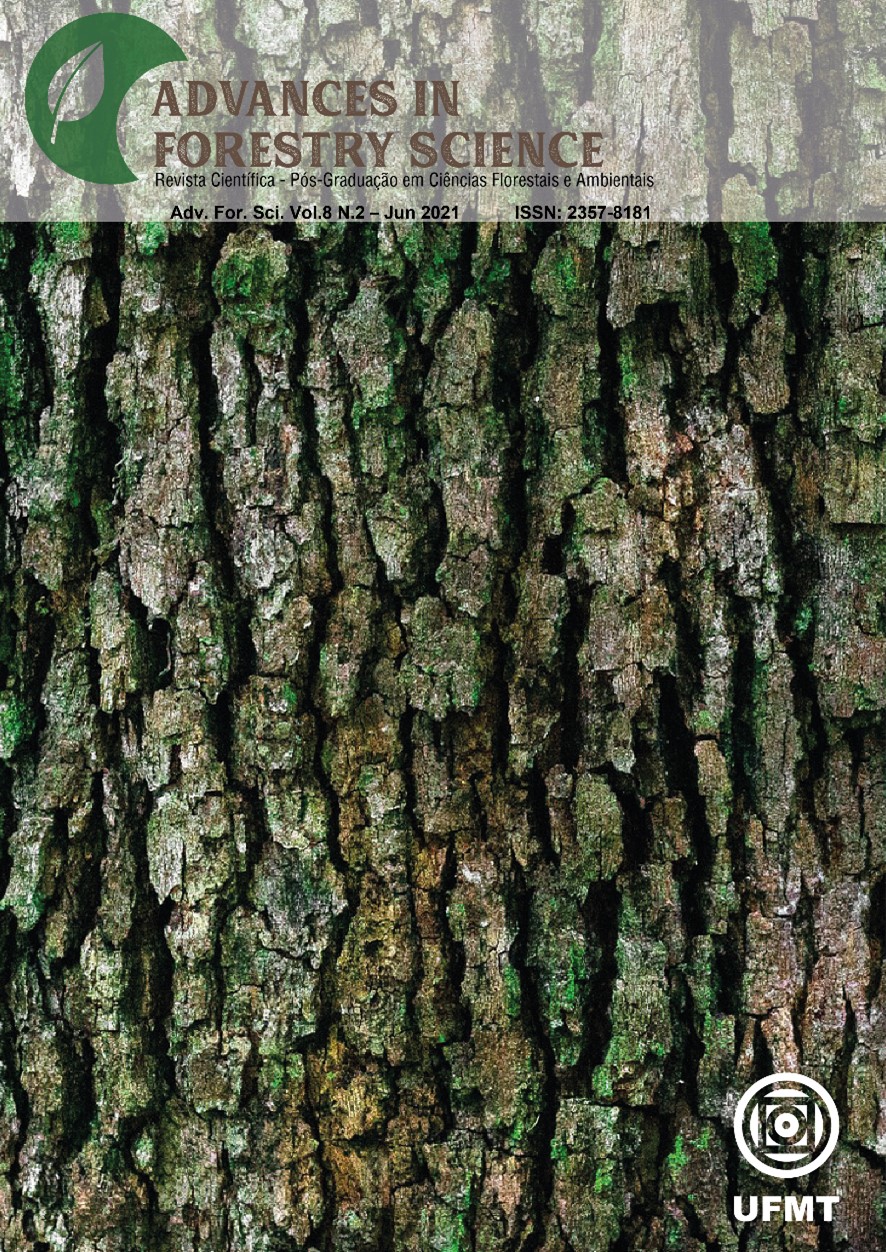Bulk density and porosity of soils influenced by skidding operations in the Nkrankwanta Off-Forest Reserve of Ghana
DOI:
https://doi.org/10.34062/afs.v8i2.9530Keywords:
Porosity, bulk density, compaction, skidding, slope, soilAbstract
Heavy forest machinery used in skidding has the capacity to influence the physical properties of soils. These may possibly lead to an upsurge in soil disruption and compaction of the soil surface decreases forest soil fertilities. This study assesses the effects of skidding on some soil physical properties such as the soil bulk density and porosity in the Nkrankwanta off-forest reserve in Ghana. The treatments comprised of four traffic intensity levels (1, 5, 10, and 15 passes) of the Mercedes Benz skidder (MB) Trac 1800 and a slope of two levels (less than 20 % and greater than 20 %) in a completely randomized block design. In addition, porosity and soil bulk density were assessed at varied distances from the MB Trac 1800. Soil bulk density results showed increasing trends with traffic frequency. Soil bulk density measured in the undisturbed area was 0.64 g cm-3 and 0.56 g cm-3 at slopes of less than 20% and greater than 20%, respectively. On the skid trail, soil bulk density significantly increased with traffic frequency (p<0.05). However soil porosity declined. Soil porosity estimated in uninterrupted area was 59.10 % and 57.40 % at < 20% and > 20% slope, respectively. Soil porosity was significantly influenced via different skidder passes (p<0.05). The soil physical properties were not influenced by the steepness of the slope however acted together in the number of passes to influence soil porosity. The impacts of the skidder on soil physical properties were significantly apparent at distances of 2 m to each sideway of the skidding trail. In conclusion, distinct responsiveness ought to be considered throughout the operations of skidding to curtail unfriendly influences on soil physical properties in ground-base skidding.
Downloads
References
Allman M, Jankovský M, Messingerová V, Allmanová Z, Ferenčík M (2015) Soil compaction of various Central European forest soils caused by traffic of forestry machines with various chassis. Forest systems 24(3): 6.
Ampoorter E, Goris R, Cornelis WM, Verheyen K (2007) Impact of mechanized logging on compaction status of sandy forest soils. Forest Ecology and Management 241: 162– 174.
Ampoorter E, Van Nevel L, Hermy LM, Verheyen K (2010) Assessing the effects of initial soil characteristics, machine mass and traffic intensity on forest soil compaction. Forest Ecology and Management 260(10): 1664 –1676.
Binkley D, Fisher RF (2013) Ecology and management of forest soils. Wiley-Blackwell, Oxford
Cambi M, Grigolato S, Neri F, Picchio R, Marchi E (2016) Effects of Forwarder Operation on Soil Physical Characteristics: a Case Study in the Italian Alps. Croatian Journal of Forest Engineering 37(2): 233-239.
Ezzati S, Najafi A, Rab MA, Zenner EK (2012) Recovery of soil bulk density, porosity and rutting from ground skidding over a 20-year period after timber harvesting in Iran. Silva Fennica 46(4): 521–538.
Jaafari A, Najafi A, Zenner EK (2014) Ground-based skidder traffic changes chemical soil properties in a mountainous Oriental beech (Fagus orientalis Lipsky) forest in Iran. Journal of Terramech 55: 39–46.
Labelle ER, Jaeger D (2011) Soil compaction caused by cut-to-length forest operations and possible short-term natural rehabilitation of soil density. Soil Science Society of America Journal. 75: 2314-2329.
Macrì G, Russo D, Zimbalatti G, Proto AR (2016) Measuring the mobility parameters of tree-length forwarding systems using GPS technology in the Southern Italy forestry. Agronomy Research 14(3): 836-845.
Najafi A, Solgi A (2010) Assessing site disturbance using two ground survey methods in a mountain forest. Croatian Journal of Forest Engineering 31(1): 47-55.
Naghdi R, Solgi A, Zenner E, Behjou FK (2018) Soil physical properties degrade further on skid trails in the year following operations. Journal of Forestry Research 29(1): 93-101. https://doi.org/10.1007/s11676-017-0413-8.
Nawaz MF, Bourrie G, Trolard F (2013) Soil compaction impact and modelling. A review. Agronomy for sustainable development 33(2): 291-309.
Solgi A, Najafi A (2014) The impacts of ground-based logging equipment on forest soil. Journal of Forestry Science 60: 28–34.
Solgi A, Najafi A, Ezzati S, Ferenˇcík M (2016) Assessment of ground-based skidding impacts on the horizontally rate and extent of soil disturbance along the margin of the skid trail. Annals of Forest Science 73: 513–522.
Solgi A, Naghdi R, Petros A, Tsioras MN (2015) Soil Compaction and Porosity Changes Caused During the Operation of Timberjack 450C Skidder in Northern Iran. Croatian Journal of Forest Engineering 36(2): 217-225.
Solgi A, Naghdi R, Marchi E, Andrea Laschi A, Keivan BF, Hemmati V, Masumian A (2019) Impact Assessment of Skidding Extraction: Effects on Physical and Chemical Properties of Forest Soils and on Maple Seedling Growing along the Skid Trail. Forest 10: 134.
Soltanpour S, Jourgholami M (2013) Soil bulk density and porosity changes due to ground-based timber extraction in the Hyrcanian forest. Notulae Scientia Biologicae 5(2): 263-269.
Downloads
Published
Issue
Section
License
All copyright must be assigned to the Federal University of Mato Grosso.

